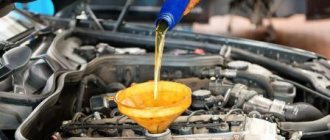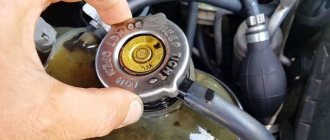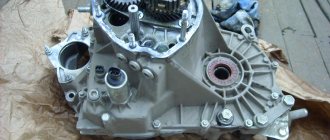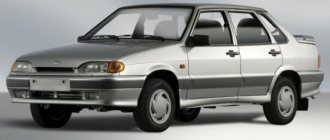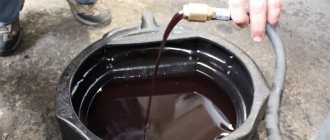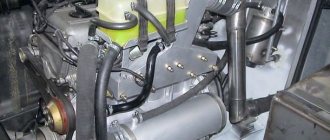Continuing the topic of flushing the engine and its systems, it should be noted that during operation quite often there is a need to flush the lubrication system. Such flushing of the oil system may be required for a number of reasons, ranging from switching to a different type of engine oil to emergency malfunctions.
As a rule, the reason for immediately flushing the lubrication system is that antifreeze or antifreeze gets into the oil, resulting in an emulsion in the engine. Even taking into account the fact that the motor oil itself has a whole package of not only protective, but also detergent and dispersant components, these properties may not be enough.
In other words, after filling, fresh oil is simply not capable of efficiently cleaning the surfaces of parts and channels in the engine from various deposits, precipitated sediment and other by-products that form after mixing with coolant.
Next, we will talk about what to do after antifreeze has been detected in the engine lubrication system, how to flush the engine after eliminating the main cause of the malfunction, and also how to flush the engine from the emulsion or its residues.
When to clean the engine
Flushing the engine with kerosene before replacing should not be done every time, as many service stations recommend, hoping to earn more money from you. The need for cleaning is determined based on the vehicle's mileage. As a rule, it is recommended to clean the engine every 70-80 thousand mileage. But in fact, no one does this, so to make control easier, we’ll set the bar at 100 thousand mileage. During this time, the surface and insides of the parts become overgrown with smudges and smoke, which must be removed, because all this reduces the power of the engine and affects its operation.
What cleaning methods are there?
Flushing the engine with kerosene before changing the oil can be done in other ways, more gentle and faster. Gentle cleaning is a more suitable option, because it does not cause any harm to the car. This is a fairly common cleansing practice. A special cleaning liquid is poured into the engine block and left there for a while, and with this liquid the car must cover 150-200 km.
Flushing the engine before changing the oil, a video of which you can view in the article, can be done periodically.
When the car has covered the required distance, it is returned to the service center, where the liquid is already drained, and along with it all the fumes and pieces of burnt material come out. As a result, the motor will work better and quieter, reception will be normalized and without interruptions, and elasticity will increase. With this procedure, it is also recommended to install new filters.
How to flush the lubrication system on all VAZ cars?
1) Flushing is actually quite simple, you can find more details on how to flush the lubrication system with one or another flushing fluid on the jar itself in which the flushing fluid is located, usually all jars have instructions for their use and they are all used in different ways, some kind of flushing fluids need to be used by starting the engine of the car and letting it run for 15 minutes so that the remaining oil leaves the system, some kind of flushing fluids need to be mixed with the engine oil itself and then drive 100-200 km and thereby The engine will also be cleaned, so as you already understand, you need to look at the instructions on the jar of liquid as everything is described in detail on it.
2) But so that you don’t forget, always remember a few rules, namely, before purchasing a fluid, make sure that it is suitable for your oil, that is, the flushing fluid is for mineral oils, as well as for synthetic oils, etc., therefore, when choosing a flush, take this into account; in addition, also pay attention to which car engine the flush is used for and you do not need to take a flush for diesel cars if in fact you have a gasoline one.
Note! In addition, if you want to make the flushing better, then you can buy a new oil filter at the auto store and install it only for the time of flushing; it doesn’t make sense to buy something too expensive since you will only need to install it and then throw it away, so take a relatively cheap one a filter that would simply act as a plug (so that oil does not leak out of the engine), and it is recommended to install a new one during flushing only because your old filter is dirty and mixing the flushing fluid with dirt will only weaken the flushing effect and thus it will not as good as it should be!
Additional video clip: For more information on how to flush the engine lubrication system, see the video located just below, everything is described in detail.
Source
If the engine runs on the same oil, then you don’t need to worry about such things as flushing. However, if you decide to change the brand of oil, you will have to carry out mandatory flushing of the engine crankcase. In this article we will tell you why you need to flush the engine with diesel fuel before changing the oil, how it is done correctly, and we will also try to answer the most common question from car enthusiasts - is it harmful?
How to quickly get the job done
Flushing the engine before changing the oil, a video of which will help you become more familiar with the technology, can be done using the express method.
It is carried out according to the same principle. A cleaning agent is poured into the block, but now the car only needs to drive for 15-20 minutes before the liquid can be washed off. The aggressive substance, which is poured into the block, cleans the metal and all elements well under the influence of high temperature. Of course, many will say why careful cleaning is needed to take the car to the service center twice, if everything can be done in one day.
The fact is that the quick cleaning solution has a strong effect on the metal, increases its wear, and if you do this cleaning 3 times in a row, it can lead to deformation of small elements. Flushing the engine with diesel fuel before changing the oil, a video of which will allow you to understand how to eliminate mistakes, can be done by you yourself.
Checking the oil level
Instructions for checking the oil level:
Advice: It is necessary to ensure that oil is not poured into the engine crankcase above the maximum mark, which can lead to fluid leakage through the seals, crankcase ventilation system and oil gaskets. If oil gets into the combustion chamber of a VAZ 2107 car that has a catalytic converter, the latter may fail.
For anyone who does car repair work with their own hands and wants to see in detail how the oil is changed in a VAZ 2107 engine, the video will show all the nuances. After a timely replacement of the oil in the VAZ 21074 engine with a new one, the service life of the entire vehicle increases significantly.
Welcome! Engine lubrication system - this includes the crankshaft (Plays a very important role), as well as the camshaft, engine crankcase and many other parts, the lubrication system is one of the most important engine systems and when it is empty (Means if the oil pour everything out of the engine), the engine will not work for a long time when it’s running, maybe it will still work for 3-4 minutes at most, but then it will simply become unusable and you will have to throw it out, in addition, the lubrication system (Many people are surprised when this they hear) cools the car engine and the engine oil itself prevents it from heating up too much.
When work is necessary
Quite often, car owners wonder when there is a need to carry out the work described in the article. This need may arise if you are planning to switch from one brand of motor oil to another. This can be attributed to their types of fuels and lubricants, since among them there are mineral, synthetic and semi-synthetic. Each of them may have a certain viscosity, and may also be manufactured by a different manufacturer. Each composition has its own unique additives, which should not be mixed with each other. If you purchased a car that was previously in use and do not know what fuels and lubricants the owner used, then it is best to carry out the work described, this will allow you to start the life of the engine from scratch.
It is necessary to carry out manipulations even after intensive use; if you drive quite quickly and a lot, then the motor may need more lubrication. After all, in this case, wear products are removed much more often. Manipulations of this kind must be carried out if the machine runs on a turbocharged engine. Such units require high quality materials, as well as ideal cleanliness.
If there is dirt, it can cause failure. Sometimes car owners dismantle the engine and then completely disassemble it. In this case, you can wash it with diesel fuel, gasoline or kerosene. It is worth noting that this method is labor-intensive, but effective. If you cannot carry out these manipulations yourself, you will need to pay for the work of mechanics.
How to flush the lubrication system on all VAZ cars?
1) Flushing is actually quite simple, you can find more details on how to flush the lubrication system with one or another flushing fluid on the jar itself in which the flushing fluid is located, usually all jars have instructions for their use and they are all used in different ways, some kind of flushing fluids need to be used by starting the engine of the car and letting it run for 15 minutes so that the remaining oil leaves the system, some kind of flushing fluids need to be mixed with the engine oil itself and then drive 100-200 km and thereby The engine will also be cleaned, so as you already understand, you need to look at the instructions on the jar of liquid as everything is described in detail on it.
2) But so that you don’t forget, always remember a few rules, namely, before purchasing a fluid, make sure that it is suitable for your oil, that is, the flushing fluid is for mineral oils, as well as for synthetic oils, etc., therefore, when choosing a flush, take this into account; in addition, also pay attention to which car engine the flush is used for and you do not need to take a flush for diesel cars if in fact you have a gasoline one.
Note! In addition, if you want to make the flushing better, then you can buy a new oil filter at the auto store and install it only for the time of flushing; it doesn’t make sense to buy something too expensive since you will only need to install it and then throw it away, so take a relatively cheap one a filter that would simply act as a plug (so that oil does not leak out of the engine), and it is recommended to install a new one during flushing only because your old filter is dirty and mixing the flushing fluid with dirt will only weaken the flushing effect and thus it will not as good as it should be!
Additional video clip: For more information on how to flush the engine lubrication system, see the video located just below, everything is described in detail.
Source
Why do you need to flush the engine with diesel fuel?
The fact that it is necessary to change the engine oil according to the regulations is known to all car owners; it is explained by the loss of the lubricant’s protective properties during operation and a decrease in the efficiency of its operation. Many articles have been written about the regulations and the need to change the lubricant in the engine, however, it is rarely mentioned that before adding new lubricant it is necessary to wash the unit from the inside. How do professionals explain this need, and how often should the procedure be performed?
The need to flush the power unit arises in the following situations:
- Changing the type of engine oil. Today, the market for fuels and lubricants is very diverse, which provokes consumers to select more effective oils for their car, which differ not only in type, but also in composition. When draining the oil, even if the procedure is carried out very efficiently, a small amount of waste fluid remains in the units of the unit and on its walls, and when filling the system with new lubricant, a “conflict” may occur between the components of the motor oils, which will negatively affect the operation of the engine.
- Changing the oil after purchasing a car on the secondary market. A similar situation in which the owner knows what kind of fluid is in the engine only from the words of the seller. Before filling the engine oil, the engine must be cleaned of previous lubricant.
- Coolant entering the system as a result of gasket deformation.
- Engine overhaul. In this case, all structural components underwent contact cleaning and were manually assembled, which is often accompanied by the entry of small particles into the system, which can negatively affect the operating life of the unit.
These precedents necessitate mandatory flushing of the power unit. In addition, flushing the engine may be necessary if the car is operated in extreme or difficult conditions, high-speed and high-temperature conditions, which provokes the formation of scale on the internal surfaces of the unit, which blocks the oil passages. You can determine the need to flush the engine by inspecting the drained liquid: if there are large particles, flakes and sludge in the waste, you will need to clean the engine from the inside in order to remove components that are dangerous to the engine.
Nowadays, service center employees recommend flushing with special liquids that are designed to clean the power unit before changing the oil. Why then did the question of flushing with diesel fuel arise? Several decades ago, the number of cars on the country’s roads was much smaller, and not every family could boast of a personal car, and accordingly, the range of fluids for servicing the engine was limited to several types of oils and diesel fuel as a means for washing it. Today the market situation has changed, but the habit remains. Many car owners still wash their engines with diesel fuel themselves and recommend this procedure to others. Moreover, some explain this fact by savings, while others indicate the high efficiency of diesel fuel as a flushing liquid.
Engine oil and its purpose
The purpose of the lubricating fluid in the power unit is clear - reducing friction, timely removal of heat and ensuring reliable operation of all mechanisms.
Ideally, oil can last indefinitely. But! The car engine operates under constant overload conditions - high pressure, sudden temperature changes and mechanical stress.
Under such conditions, the oil begins to lose its properties and oxidize. Such “waste” ends up in a variety of places - deposited in engine gaps, oil grooves and other engine elements.
Each time the quality of the lubrication of the power unit becomes worse. This, in turn, affects the characteristics of its work. It turns out to be a chain reaction.
As a result of oil oxidation, a whole “bouquet” of foreign elements appears - resinous and carbon deposits, as well as acids. The action of the latter (acids) accelerates the process of corrosion formation and changes the characteristics of the oil.
Over time, the following appears on the internal elements of the engine:
Against the background of the above material, the question of whether the engine needs to be flushed becomes even more relevant. Moreover, there are many versions.
Some experts recommend buying special flushing oil, others - ordinary mineral water, and still others are generally against any additional flushing processes. So who is right?
Pros and cons of diesel fuel as a flushing fluid
Indeed, one of the advantages of diesel fuel in comparison with special means is the pricing policy. Flushing the engine with diesel fuel before changing the oil will be much cheaper than carrying out this procedure using purchased emulsions. The second argument in favor of diesel fuel is its use in all CIS countries for cleaning engines of domestically produced equipment, as well as its applicability for engines of special equipment. The effectiveness of this method is proven by the large number of domestically produced cars on the roads at the present time, which perfectly perform their functions despite their advanced age.
But the following fact casts doubt on the benefits of diesel fuel for the engine. Many users explain the effectiveness of diesel fuel when flushing the engine before changing the oil by the fact that it is actively used to clean engine elements during major repairs by professionals. And this is true, diesel fuel actively cleanses the elements of scale, dirt and sludge. However, opponents of the theory argue that when cleaning parts during a major overhaul, these components are not only affected by diesel fuel, but also a significant mechanical force is applied, due to which a positive result is achieved.
In addition, many experts note that when flushing the engine, diesel fuel does not break down the scale on the parts, but acts by peeling it off from the internal surfaces. Since it is almost impossible to completely remove these particles during the washing process, some of the coarse components will remain in the engine, and when oil is added, the particles will freely circulate through the system, causing damage to it and blocking small passages, thereby causing oil starvation of individual engine components. Additionally, doubts about the effectiveness of diesel fuel in cleaning the power unit are caused by the effect of the liquid on oil seals, gaskets and seals. Diesel fuel can cause their deformation, which will affect not only the functionality of the motor, but also its performance characteristics, and can cause its premature failure.
An impressive list of both positive characteristics of diesel fuel as a flushing fluid and negative factors makes you wonder whether it is possible to flush the engine with diesel fuel when changing the oil. There is no clear answer to this question. In practice, over the years of its use, diesel fuel has earned popularity in relation to the engines of domestically produced cars with significant mileage. Some owners of used foreign cars also actively use this method of cleaning the power unit and confirm its effectiveness. As for new or warranty cars, foreign cars with low mileage, engines of modern modifications, here the opinion of professionals is unequivocal - such a procedure is strictly prohibited, since it may not only not produce results, but also harm the engine. In addition, even for old cars, the procedure should be performed only when the need arises, but not at every oil change.
Why do you need to flush the engine oil system?
If the engine has been running for a long time on the same lubricant component, then sooner or later the question will arise about improving the quality of the oil by changing its brand. It is worth noting that oil manufacturers use different technologies to produce different varieties. Differences may lie in both the production method and the chemical composition of the lubricant.
Any car owner knows that oil is very thick, which prevents the oil from draining completely. Naturally, oil residues remain in many channels, which for some reason could not leave the engine crankcase. Filling in new oil with a different density and composition does not bode well.
Everyone understands that substances with different densities or any other properties, when mixed, give a new substance or push each other out. Many oil additives can even cause an engine explosion because they come into contact with the provoking component of oil residues. Diluting oils with different viscosities also does not give a positive result. In this case, the properties of the oil change greatly, and it will no longer be able to ensure efficient operation of the engine in a given season.
This is precisely why flushing is used, which cleans the crankcase of old oil residues, as well as many types of contaminants that have become firmly attached to the crankcase walls over the years. Thus, we get a clean motor into which almost any oil can be poured.
The process of flushing the engine with diesel fuel
If, after weighing all the pros and cons, you decide to clean the engine with diesel fuel, you trust more in the experience of your ancestors, which has proven its effectiveness over the years, than in modern liquids, we will tell you how to carry out this procedure correctly and correctly. The methodology for flushing the engine with diesel fuel when changing the oil is not particularly complicated or requires significant investment. To complete this task, you will need to stock up on diesel fuel, in a volume of at least eight liters, two oil filters, one of which must be of high quality, preferably an original element for your car, the other can be the cheapest, since it will only be used when cleaning the power unit.
The procedure is carried out immediately after draining the used oil. It is recommended to drain the waste in a pit or overpass, on a warm engine, through the oil drain hole on the crankcase pan. Sometimes this will require removing the power unit protection, if it is provided by the vehicle modification. Detailed instructions for changing the fluid in the power unit for a specific car model can be found in the user manual or in articles on this topic on our website. After draining the used motor oil, you need to dismantle the worn-out oil filter and install a purchased filter element in its place.
Let's sum it up
Diesel oil has been used by car owners for many decades as an effective and gentle means for washing the power unit. Today, the effectiveness of the diesel fuel flushing procedure is questioned by many automakers and service center employees; alternatives are considered to be the use of specific liquids to clean the engine. However, a detailed study of the composition of special emulsions for washing the engine raises doubts and controversial issues, since effective removal of soot and dirt using special liquids is achieved due to the presence of aggressive chemical components in them, which can also negatively affect the unit components.
As many years of practice have proven, the method of flushing the engine with diesel fuel has a right to exist, is characterized by high efficiency against the backdrop of low costs, and is considered a gentle way to clean the engine. Each car owner has the right to decide independently which product to choose; however, when performing the flushing, you should act very carefully, follow the instructions, do not overheat the engine - and the result will live up to expectations. Better yet, keep an eye on the engine of your car, try to avoid overheating and stress, change the oil in a timely manner - and the engine will not need such procedures.


